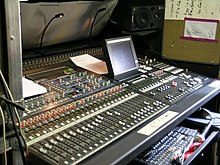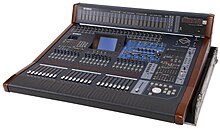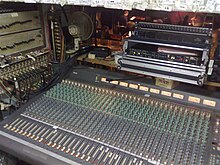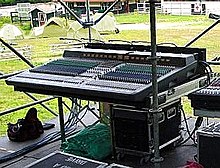
An audio power amplifier amplifies low-power electronic audio signals, such as the signal from a radio receiver or an electric guitar pickup, to a level that is high enough for driving loudspeakers or headphones. Audio power amplifiers are found in all manner of sound systems including sound reinforcement, public address, home audio systems and musical instrument amplifiers like guitar amplifiers. It is the final electronic stage in a typical audio playback chain before the signal is sent to the loudspeakers.

A mixing console or mixing desk is an electronic device for mixing audio signals, used in sound recording and reproduction and sound reinforcement systems. Inputs to the console include microphones, signals from electric or electronic instruments, or recorded sounds. Mixers may control analog or digital signals. The modified signals are summed to produce the combined output signals, which can then be broadcast, amplified through a sound reinforcement system or recorded.
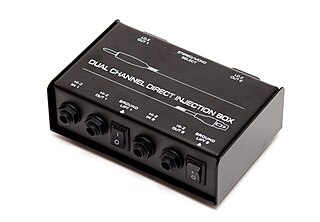
A DI unit is an electronic device typically used in recording studios and in sound reinforcement systems to connect a high output impedance unbalanced output signal to a low-impedance, microphone level, balanced input, usually via an XLR connector and XLR cable. DIs are frequently used to connect an electric guitar or electric bass to a mixing console's microphone input jack. The DI performs level matching, balancing, and either active buffering or passive impedance matching/impedance bridging. DI units are typically metal boxes with input and output jacks and, for more expensive units, “ground lift” and attenuator switches.

A stage box is an interface device used in sound reinforcement and recording studios to connect equipment to a mixing console. It provides a central location to connect microphones, instruments, and speakers to a multicore cable (snake), which allows the sound desk to be further from the stage and simplifies setup.
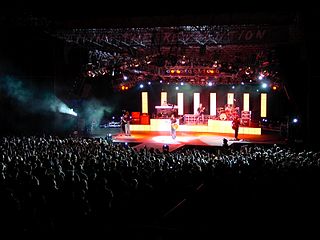
A sound reinforcement system is the combination of microphones, signal processors, amplifiers, and loudspeakers in enclosures all controlled by a mixing console that makes live or pre-recorded sounds louder and may also distribute those sounds to a larger or more distant audience. In many situations, a sound reinforcement system is also used to enhance or alter the sound of the sources on the stage, typically by using electronic effects, such as reverb, as opposed to simply amplifying the sources unaltered.
Solid State Logic Ltd. (SSL) is a British company based in Begbroke, Oxfordshire, England that designs and markets audio mixing consoles, signal processors, and other audio technologies for the post-production, video production, broadcast, sound reinforcement and music recording industries. SSL employs over 160 people worldwide and has regional offices in Los Angeles, Milan, New York City, Paris, and Tokyo, with additional support provided by an international network of distributors. Solid State Logic is part of the Audiotonix Group.
Shure Inc. is an audio products corporation headquartered in the USA. It was founded by Sidney N. Shure in Chicago, Illinois, in 1925 as a supplier of radio parts kits. The company became a consumer and professional audio-electronics manufacturer of microphones, wireless microphone systems, phonograph cartridges, discussion systems, mixers, and digital signal processing. The company also manufactures listening products, including headphones, high-end earphones, and personal monitor systems.
TASCAM is the professional audio division of TEAC Corporation, headquartered in Santa Fe Springs, California. TASCAM established the Home Recording phenomenon by creating the "Project Studio" and is credited as the inventor of the Portastudio, the first cassette-based multi-track home studio recorders. TASCAM also introduced the first low-cost mass-produced multitrack recorders with Simul-Sync designed for recording musicians, and manufactured reel-to-reel tape machines and audio mixers for home recordists from the early 1970s through the mid-1990s. Since the early 00's, TASCAM has been an early innovator in the field-recording and audio accompaniment to video with their DR-series recording platforms. TASCAM celebrated its 50th anniversary in 2021.

An aux-send is an electronic signal-routing output used on multi-channel sound mixing consoles used in recording and broadcasting settings and on PA system amplifier-mixers used in music concerts. The signal from the auxiliary send is often routed through outboard audio processing effects units and then returned to the mixer using an auxiliary return input jack, thus creating an effects loop. This allows effects to be added to an audio source or channel within the mixing console. Another common use of the aux send mix is to create monitor mixes for the onstage performers' monitor speakers or in-ear monitors. The aux send's monitor mix is usually different from the front of house mix the audience is hearing.

A DJ mixer is a type of audio mixing console used by disc jockeys (DJs) to control and manipulate multiple audio signals. Some DJs use the mixer to make seamless transitions from one song to another when they are playing records at a dance club. Hip hop DJs and turntablists use the DJ mixer to play record players like a musical instrument and create new sounds. DJs in the disco, house music, electronic dance music and other dance-oriented genres use the mixer to make smooth transitions between different sound recordings as they are playing. The sources are typically record turntables, compact cassettes, CDJs, or DJ software on a laptop. DJ mixers allow the DJ to use headphones to preview the next song before playing it to the audience. Most low- to mid-priced DJ mixers can only accommodate two turntables or CD players, but some mixers can accommodate up to six turntables or CD players. DJs and turntablists in hip hop music and nu metal use DJ mixers to create beats, loops and so-called scratching sound effects.

Automated Processes Inc. is an American company that designs, manufactures, and markets mixing consoles and signal processors, including modular signal processor units in the 500-series format standard that evolved from early API mixing consoles.
Harrison Audio Consoles is an international company based in Nashville, Tennessee that manufactures high-end mixing consoles, Digital Audio Workstations (DAW), audio plugins, and other audio technologies for the post-production, video production, broadcast, sound reinforcement and music recording industries. The company is renowned as an industry innovation for its "in-line" mixing console design that has subsequently become the standard for nearly every large-format music console. Over 1,500 Harrison consoles have been installed worldwide, presenting a significant percentage of the overall world market share for high-end audio consoles. The company founder, Dave Harrison, was inducted as a Fellow in the Audio Engineering Society for this technical contribution of the recording industry and in particular the first 32-bus "in-line" console.

In professional audio, a digital mixing console (DMC) is a type of mixing console used to combine, route, and change the dynamics, equalization and other properties of multiple audio input signals, using digital signal processing rather than analog circuitry. The digital audio samples, which is the internal representation of the analog inputs, are summed to what is known as a master channel to produce a combined output. A professional digital mixing console is a dedicated desk or control surface produced exclusively for the task and is typically more robust in terms of user control, processing power and quality of audio effects. However, a computer can also perform the same function since it can mimic its interface, input and output.
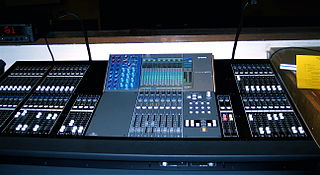
The Yamaha M7CL is a digital mixer that was introduced by Yamaha Pro Audio in 2005. Two models with onboard analog input exist: the M7CL-32 and M7CL-48. These models have 40 - and 56 -input channels respectively, counting mono channels. Mixes, masters, groups, DCAs and individual channels can then be routed to an output via any number of the board's 16 configurable output XLR ports. The eight faders of the master control section can control multiple functions by way of "layers" in the same manner as the Yamaha PM5D. The board features Yamaha's "Selected Channel" technology, and Centralogic, unique to the M7CL. It can be augmented with more inputs or outputs via expansion cards, and can be fitted with third-party cards such as ones made by Aviom (A-Net), AuviTran (EtherSound), Audinate, AudioService (MADI), Dan Dugan (automixer), Riedel Communications (RockNet), Waves Audio, and Optocore. In 2010, the M7CL-48ES joined the line-up with built-in EtherSound for digital networking using EtherSound stage boxes.

Live sound mixing is the blending of multiple sound sources by an audio engineer using a mixing console or software. Sounds that are mixed include those from instruments and voices which are picked up by microphones and pre-recorded material, such as songs on CD or a digital audio player. Individual sources are typically equalised to adjust the bass and treble response and routed to effect processors to ultimately be amplified and reproduced via a loudspeaker system. The live sound engineer listens and balances the various audio sources in a way that best suits the needs of the event.
VENUE is a brand of live sound digital mixing consoles introduced by Digidesign in February 2005. The family now includes 5 different consoles and a number of ways they can be configured. They can all be connected to Pro Tools, the audio editing software also created by Avid/Digidesign, to provide recording and 'Virtual Soundcheck' facilities. One of the system's key marketing points is its use of the same AAX DSP/TDM plugins as Pro Tools, an industry standard digital audio workstation (DAW). This is designed to enable the sounds recorded by the artist in the studio to be easily recreated on stage, and to allow for greater flexibility in signal processing without heavy and mechanical-shock-sensitive racks of external processors. There is also a PC-based offline editor for creation and editing of show files, although there is no audio processing in the editor.

An automixer, or automatic microphone mixer, is a live sound mixing device that automatically reduces the strength of a microphone's audio signal when it is not being used.
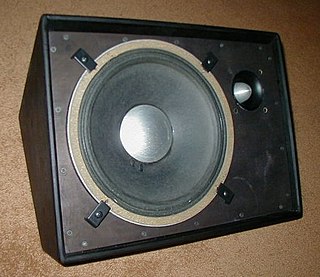
A stage monitor system is a set of performer-facing loudspeakers called monitor speakers, stage monitors, floor monitors, wedges, or foldbacks on stage during live music performances in which a sound reinforcement system is used to amplify a performance for the audience. The monitor system allows musicians to hear themselves and fellow band members clearly.

Smaart is a suite of audio and acoustical measurements and instrumentation software tools introduced in 1996 by JBL's professional audio division. It is designed to help the live sound engineer optimize sound reinforcement systems before public performance and actively monitor acoustical parameters in real time while an audio system is in use. Most earlier analysis systems required specific test signals sent through the sound system, ones that would be unpleasant for the audience to hear. Smaart is a source-independent analyzer and therefore will work effectively with a variety of test signals including speech or music.

A matrix mixer is an audio electronics device that routes multiple input audio signals to multiple outputs. It usually employs level controls such as potentiometers to determine how much of each input is going to each output, and it can incorporate simple on/off assignment buttons. The number of individual controls is at least the number of inputs multiplied by the number of outputs.





